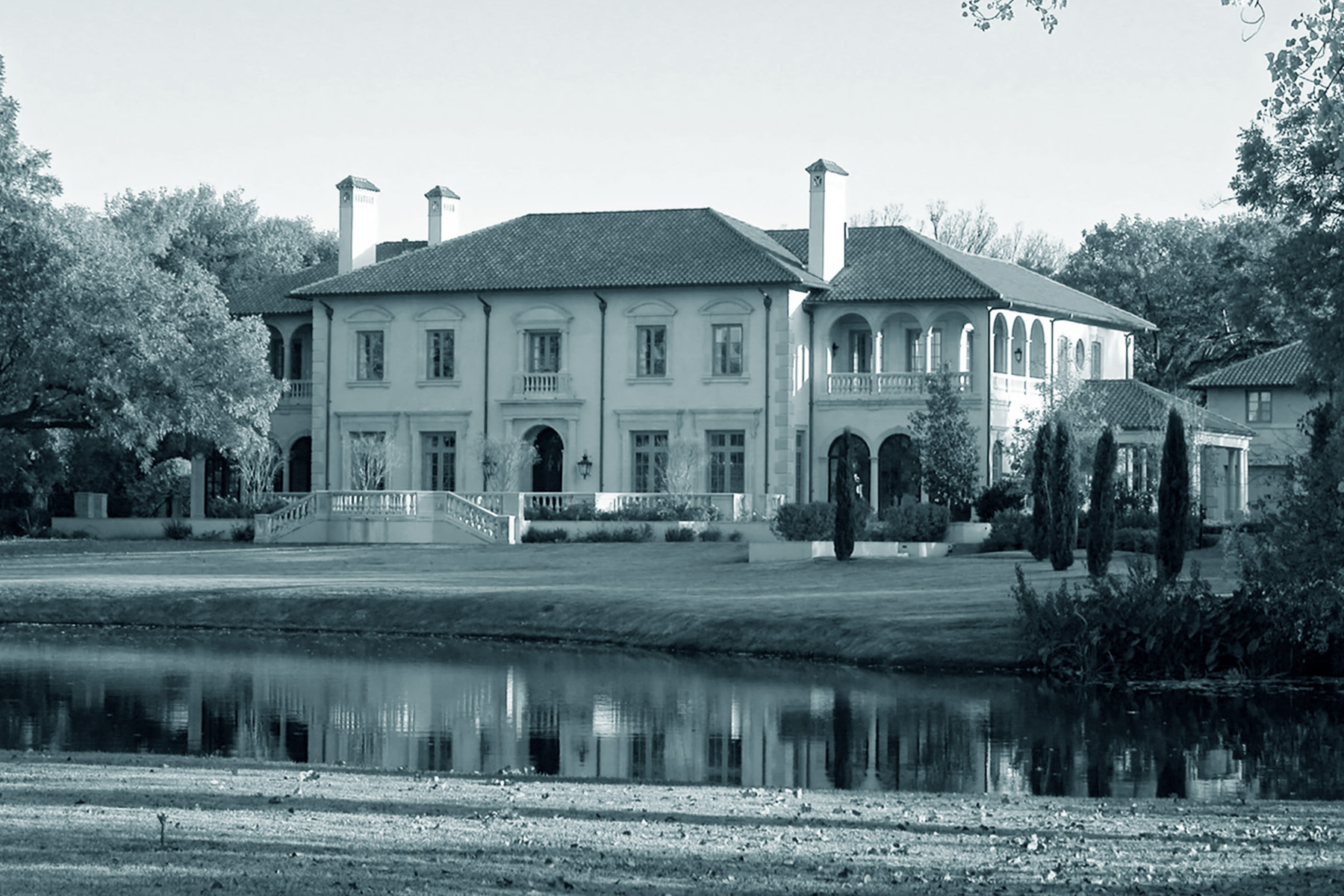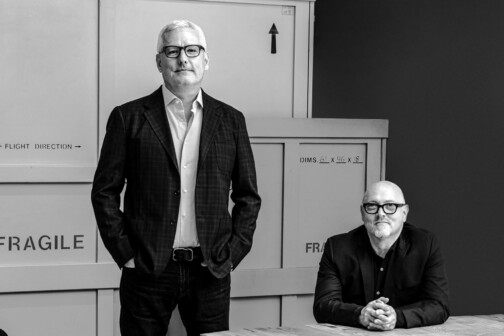Residential architects give shape to our lives in the most intimate of spaces: our homes. The good ones turn our amorphous wants, needs, and habits into corners, cutouts, and curves; the great ones elevate that practice to an art form.
Dallas is fortunate to have had many masters of this craft call it home. Wilson Fuqua and Max Levy are two of them. We invited the preservation-minded traditionalist and the modernist, respectively—both of whom are celebrating 40 years in practice—to come together for an enlightening and inspiring conversation about their processes, their points of view, the state of architecture in Dallas today, and their own legacies. Plus: Discover which firms made the list of Best Architects in Dallas 2023.
This transcript has been edited for length and clarity.
On Finding Their Calling & Points of View
- Max Levy
- Wilson Fuqua
“I was 7 years old. I was out on Lake Michigan, in a relative’s cabin cruiser, looking back at the skyline of Chicago. This is back in the 1950s, and the skyline at that time was uniformly sort of brownish masonry buildings. Except for one. It was a brand-new Mies van der Rohe high-rise, the Lake Shore towers. Classic. It was a little black painted grid of steel. And it was like the architectural Cupid’s arrow. … I’ve known since I was a little kid that that’s what I wanted to do.”
“I worked for [the late modern architect] Frank Welch for a year, and then he let me go. He said, ‘Well, we’re redoing our offices, and we just don’t really have plans. And besides that, you’re not really a modernist.’ I later went back to him, and I said, ‘I have these two former roommates that are starting this firm, and they’re doing traditional architecture in Dallas. What do you think of me going out and doing traditional architecture?’ He goes, ‘Wilson, that’ll never work. Nobody spends enough money to do it right.’ I obviously didn’t take his advice. But taking advice is more than doing what somebody tells you to do—it’s to cause you to think about why you might not do it or what you should do. And so I just decided, ‘Well, this is something I’m going to do.’ But I had enough respect for Frank that I wanted to know his opinion.”
On Modern & Traditional Architecture
ML: “Oscar Wilde said—I’m going to paraphrase it—the best work of any historical era is forever modern. He said this back in 1890, so modernism back then didn’t mean what it means today. But he meant that the good work of any era is forever good, and they’re all cousins. That’s the way I feel about it. I think the foundation of [traditional and modern] have similar values. The difference is that traditional gets into elaboration and modern tends to edit, edit, edit. …
There’s a spectrum of modernism. … At one end, there’s what I call poetic modernism. And at the other end, there’s what I call cut-and-paste modernism. Poetic modernism is created with almost a meditative patience of adjusting and refining the proportions, … and it also takes great pleasure in the plain-spoken beauty of natural materials. It shows a great allegiance to the lay of the land and to the weather that it happens to be standing within. And then all of that is sort of washed in the spiritualizing effects of natural light.
At the other end of the spectrum—that cut-and-paste modernism—it is rushed; it can’t be methodical or meditative at all. The marketplace is pushing it, and it’s pushing it so fast that there’s no conceptual framework for it. And this is why this stuff that people call modern, the cut-and-paste stuff, does seem just sort of scattered. And as a result, they generally don’t make good neighbors in more traditional neighborhoods. …
I think of traditional design as classical music, and I think of modernism as jazz. Jazz will take an old standard or tune that everybody knows and fool around with it and bring to it an emotional dimension, or a psychological or conceptual dimension, that allows you to hear that tune like you’ve never heard it before. For me, that’s what happens with modernism—the standard that I start with is the idea of a floor plan, but you can kind of play around with it the same way jazz plays around with a tune.”
WF: “You can say the same thing with classicism, where you have the four orders of the different kinds of columns, and all the proportioning systems, and that kind of thing. As a young architect, you learn what the standard is. And then you learn: If I want to have this effect, I change the standard—I break all the rules. I make this column taller and thinner than you normally would. And that becomes Federal or neoclassical or whatever. There’s sort of a starting point that’s a generally accepted right thing, but it’s the interpretive quality to it that makes it really come alive.
What’s so interesting is to see different cultures building the same thing at different times, all the different revivals of architecture. Greek revival, neoclassical—they all have an imprint of a time and what was considered beautiful at that time. So it’s interesting to see all those different manifestations. So you can make all sorts of little historical interpretations that can completely change the way a house feels.”
ML: “I cannot imagine working with that kind of encyclopedic rule book. … I’m more or less in the improvisation, and it is so hard, because I don’t have that set of rules. But I like the freedom.”
WF: “You’ve created probably your own set of rules.”
ML: “In a way, yeah. The thing I have loved about modernism is that it allows you to stay in the here and now and magnify the joy of being alive. I’ve discovered that architecture has this marvelous capacity to reframe our appreciation of nature in our midst. By that, I mean, literally, it can frame your attention to certain phenomena. … Architecture can frame a view of a wall in a way that when the sun casts shadows across it and the shadows slowly move, the whole building becomes a sundial. You can design a building to heighten the occupant’s awareness of the passage of time or the presence of nature.
All this is to say that the reason I love modernism is it gives me the freedom to articulate these things, so that you can bring moments of relief to people’s hectic, crazy lives.”
On Architectural Philosophy, Process, & the Never-Ending Pursuit of Perfection
WF: “One of the things that I remember from architecture school was [Swiss-French architect Le] Corbusier said that good design’s a patient search. And the other was the design theory of [Finnish architect Alvar] Aalto. The idea was: When you’re designing a building, you go to the site, you see everything there is to know about the site, you get surveys, … you cram all these different things into your head—as much information as you can. And then, he said, you get a two-o’clock-in-the-morning feeling, and you draw a childlike drawing. … The way that it works is, at least among architects, is that you go through this process, and then at some point, it all comes together, and it just kind of blurts out. And so that’s kind of the start of a concept. One of my clients said, ‘You know, Wilson, you have the reputation for being the slowest architect in Dallas.’ And I should have said, ‘No, I’m not. Max Levy is.’ [Laughs]”
ML: “[Laughs] You should have said, ‘Thank you.’ ”
WF: “I should’ve said, ‘Thank you.’ I lived in this world where all my competitors were doing a lot of spec houses, and I was just trying to get work. They were feverishly putting out all these drawings, designing all these buildings, and they were doing it really quick. And I’m going, ‘Gosh, what’s wrong with me? I can’t do this.’ Then I started getting some clients that really loved architecture, and the clients that really loved architecture were very patient.
I asked one of my friends, [architect] Cole Smith, ‘When is the last drawing that you do for a project?’ And he said, ‘Wilson, the day when they move in.’ He draws the whole time. It takes refinement, because no matter what you’re looking at in a building, you study it, and you think, ‘Well, I think I’ve done this!’ You pat yourself on the back, and you come back a week later and you go, ‘That doesn’t look quite right, this isn’t really balanced right, this isn’t the right color.’ You live with this sort of gnawing thing that you haven’t done it yet, that it’s not right, and that it can be better. And that’s what it takes to have good architecture—to have that thing inside that it’s not finished yet, that you’ve got to do more.
I was working for Frank Welch, and we were doing this project, and the drawings were supposed to go out. He came in the studio, and he goes, ‘No, no, no! Stop everybody! We need to redraw this; we need to redesign this part of the house.’ I thought, ‘Wow, this is really wild. What are we going to do? We’re not going to meet our deadlines.’ And it’s like, no, you’ve got to do it right. That had a big effect on me, because it’s not really finished until it’s finished and until you’ve got most of those gnawing things addressed. … ”
WF: “I try to do a little bit of both. [Laughs] I did a little bit of trying to get work out so that I could do more work on better projects.”
ML: “Of course, there’s an element of that.”
WF: “And there’s a lot of going back and forth, depending on who’s out there wanting. It’s whoever’s calling on the phone.”
ML: “Designing involves this unrelenting cycle of elation and despair—
it’s just exhausting. But you have to learn to hang in there when the despair shows up and just keep on methodically moving through the problem. Usually, you get to an answer. It’ll tell you.”
WF: “The worst thing, though, is when it’s finished and you go, ‘Gosh, I should’ve done [this or] that.’ You see all the things that could have been better. Because you never quit thinking of something that can be better. You’re always having to outdo yourself. It’s kind of like opera: You’ve got to go out there and hit all the high notes the best you can every time you go out, because people have high expectations. And it doesn’t matter what you did yesterday—it’s, What are you doing today?
ML: “Early in my career, I noticed that all the architects I was familiar with, their credo was to do more work in less time. When I went out on my own, I attempted to do less work in more time. It’s just the only way I knew how to work. I found that by doing less work in more time, the quality and the projects that emerged were better, and that brought in more work. And that, for 40 years, has been my business plan.
On Architecture in Dallas Today
ML: “Dallas is determined to wind up at the end of its life and be brand-new. It has done such a good job of tearing itself down. At the same time, from my perspective, Dallas seems to express its artistic and cultural aspirations through its houses much more so than its civic buildings. … I find that fascinating. …
But I’ve just always been very troubled by how Dallas just keeps tearing it all down. If Dallas still had a fraction of the buildings that were here, say, around the turn of the century, it would be literally one of the most interesting cities in the country right now. …”
WF: “My mother raised me to be a preservationist. She loved historic architecture … , so she kind of primed it so that I would be a preservationist. …
They say that a bad economy is the friend of the preservationist, because there’s not as much tearing down going on. … You come in these neighborhoods, and the values of all these houses just keep going up and up and up, so the relative value of any particular house—especially in Highland Park—just becomes worthless. So when people start looking for houses, they don’t look for houses; they look for lots. Houses become invisible. It doesn’t matter who the architect was or when it was built.
Highland Park is the absolute worst place anywhere for preservation. And I say that having worked for clients that love historic houses, they love their neighborhood, and they do something that makes an old house look like a new house. … But there’s just not that many people that want that. There’s a lot more people—especially with the influx of people moving here from other states—that have no framework or context of what should come or what should go. They just want to find a lot; they just want to build.”
ML: “It’s feverish. … I’m often asked, ‘What’s the latest trend in residential architecture?’ And, honestly, the trend is more square footage, more volume, more energy consumption, more water consumption, more stuff, more stuff, more stuff. It’s unsustainable. And hopefully, at some point, society will come to its senses, at least enough to start thinking about a building being less into having and more into being.”
On the Greats of Dallas Architecture
ML: “I was fortunate to work for Bud Oglesby. He was an early modernist in Dallas. Tragically, probably most of his houses have been torn down, but they were extraordinary. … Working for Bud was like graduate school. I’ve never seen anyone more sensitive to the lay of the land. … It’s little known that Bud actually worked for Aalto. And he brought back to Dallas this sort of Scandinavian, modern quality—it’s very edited, it’s very minimal but very warm. It’s a form of modernism that is rare. If there was more of it, more of the general public would have a fondness for modernism and understand it more. … All of Bud’s projects made good neighbors. They could fit into any traditional neighborhood—they were so gentle, so easy on the eye. That’s the kind of modernism I wish we could get back to today, particularly in Dallas, with the mentality of bigger, bigger, more, more. … If a neighborhood is an orchestral piece of music, you don’t want to be going down the block and all of a sudden get some loud trumpet blasts that are a little off key. That’s what a lot of this bombastic modernism is doing—and what’s giving modernism a bad name. …
Slightly preceding Bud was Howard Meyer. His work was beautiful. I think probably most of it’s been torn down. But again, it was not the kind of stark modernism that is life-defying. It’s always warm materials and definitely humanized with craft.”
WF: “If someone asked me to do a modern house, I would do something probably that would look more like [Texas architect] O’Neil Ford—like Tom Slick’s house that has a roof that’s six inches thick that’s a slab of concrete, and then just windows all the way up.”
ML: “His houses always explained how they were built. When you saw a brick wall in an O’Neil Ford house, it was a load-bearing brick wall. He never did veneers. In fact, he called houses that had veneer ‘veneer-eal architecture. …’ ”
WF: “Modernism gave us the ability to do all sorts of things with materials. … You could treat brick like it’s wallpaper, so all of a sudden, brick loses its meaning. One of the things that I love about [Dallas eclectic architect Charles] Dilbeck is the way he [used] brick. He thought of brick as a craft. He has basketweave brick, which undulates in and out; he has crazy brick that goes up and down, where the joints aren’t flat; and he has crazy flatwork, and all the bricks are skewed. But there’s this joy of life. I say he [taught] bricks how to sing and dance.”
On Their Own Legacies
ML: “I would be happy if people said that my buildings lifted them above life’s complications.”
WF: “I don’t think of legacy so much. I guess I’m maybe too much in the present.”
ML: “Well we know in Dallas, all of our buildings will be torn down. [Laughs]”
WF: “They’ll be gone. [Laughs] … I just really want people to enjoy living in the houses that I create for them. Like what you said, it makes life easier to live. Life is hard, and houses are places where people celebrate birthdays and have Christmas. My roommate from architecture school said, ‘One of the most important things about designing a house is having a really good place for a Christmas tree.’ … So yeah, one good Christmas tree [spot].”
Author










